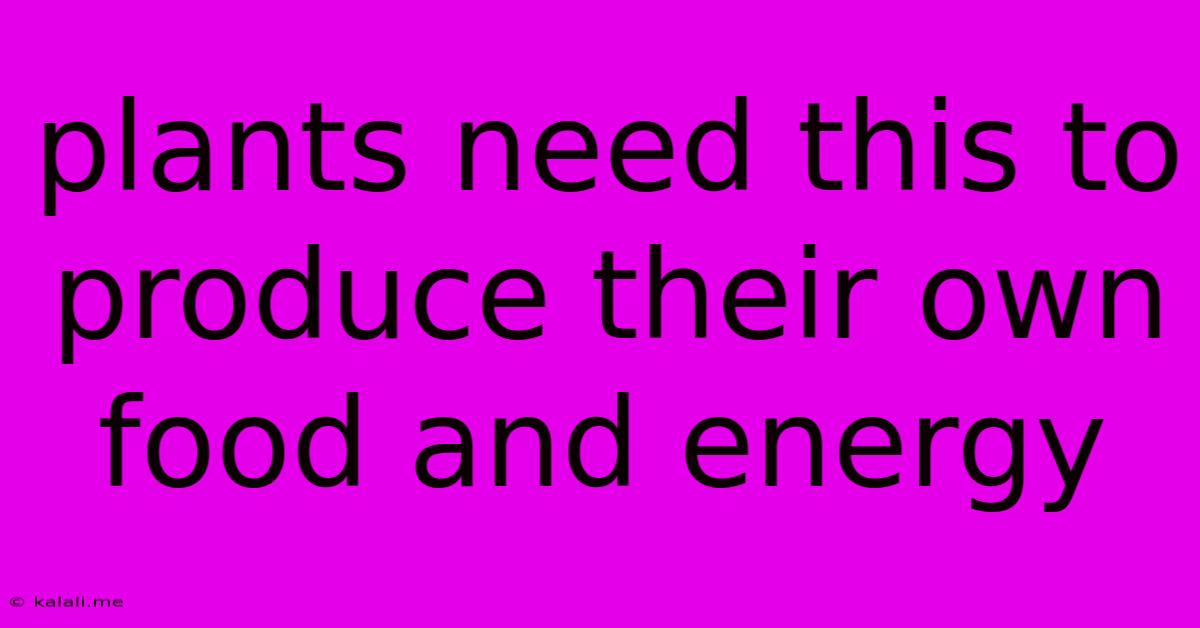Plants Need This To Produce Their Own Food And Energy
Kalali
May 10, 2025 · 3 min read

Table of Contents
Plants Need Sunlight, Water, and Carbon Dioxide to Produce Their Own Food and Energy
Photosynthesis is the remarkable process by which plants create their own food and energy. This essential process allows plants to thrive, providing the foundation for most of Earth's ecosystems. But what exactly do plants need to fuel this vital life function? The answer lies in three key ingredients: sunlight, water, and carbon dioxide. Understanding these requirements is crucial to appreciating the intricate workings of the plant world and their role in maintaining the planet's delicate balance.
The Power of Sunlight: The Engine of Photosynthesis
Sunlight serves as the primary energy source for photosynthesis. The chlorophyll within plant cells, specifically in the chloroplasts, captures the sun's energy. This energy is then used to drive the chemical reactions that convert water and carbon dioxide into glucose (a sugar that serves as the plant's food) and oxygen. Different plants have adapted to utilize varying levels of sunlight, ranging from shade-loving plants to those thriving in direct sunlight. The intensity and duration of sunlight significantly impact the rate of photosynthesis. The wavelength of light also plays a role, with plants primarily absorbing red and blue light.
Water: The Essential Raw Material
Water is not merely a byproduct of photosynthesis; it's a crucial reactant. Through a process called photolysis, water molecules are split, releasing electrons that are vital for the electron transport chain within the chloroplasts. These electrons are essential for converting light energy into chemical energy. The availability of water directly affects the rate of photosynthesis. Drought conditions can severely limit a plant's ability to produce food, leading to stunted growth and potentially death. The absorption of water, primarily through the roots, transports vital nutrients and minerals alongside water to support the photosynthetic process.
Carbon Dioxide: The Building Block
Carbon dioxide from the atmosphere enters the plant through tiny pores called stomata, located primarily on the underside of leaves. These stomata regulate the intake of carbon dioxide and the release of oxygen. Carbon dioxide acts as the carbon source for building glucose, the plant's primary energy source. The concentration of carbon dioxide in the atmosphere can also influence the rate of photosynthesis, with higher concentrations generally leading to increased productivity (though other factors, such as water availability and temperature, become limiting factors at higher CO2). The process of incorporating carbon dioxide into organic molecules is called carbon fixation.
The Outcome: Glucose and Oxygen
The ultimate products of photosynthesis are glucose (a simple sugar) and oxygen. Glucose provides the plant with energy and the building blocks for growth and development. Oxygen is released as a byproduct and is essential for the respiration of many organisms, including animals and plants themselves. This oxygen production makes plants crucial for maintaining the oxygen levels in our atmosphere.
Understanding Photosynthesis for Better Gardening and Environmental Awareness
Understanding the requirements for photosynthesis – sunlight, water, and carbon dioxide – is key to successful gardening and a greater appreciation for the environment. By providing plants with optimal conditions, including sufficient sunlight, adequate watering, and ensuring good air circulation (for carbon dioxide access), we can promote healthy plant growth and maximize their productivity. This knowledge also highlights the importance of preserving forests and green spaces, which play a vital role in maintaining the Earth's carbon dioxide balance and oxygen production. The interconnectedness of plants, their environment, and the broader ecosystem is clearly demonstrated by this remarkable process.
Latest Posts
Latest Posts
-
What Is 2 3 Of 3 Quarts
Jul 02, 2025
-
Courtesy Is Cumbersome To Them That Know It Not
Jul 02, 2025
-
How Far Is 220 Yards On A Track
Jul 02, 2025
-
What Is The Shortest Chapter In The Bible
Jul 02, 2025
-
What Has 4 Letters Sometimes Has 9
Jul 02, 2025
Related Post
Thank you for visiting our website which covers about Plants Need This To Produce Their Own Food And Energy . We hope the information provided has been useful to you. Feel free to contact us if you have any questions or need further assistance. See you next time and don't miss to bookmark.